| close window |
General Information
On this page:
Every player needs to find the size and style of mouthpiece which best suits both his or her physical and musical requirements. Since different mouthpieces can emphasize different embouchure muscles, it is difficult to pinpoint the ideal mouthpiece at a single testing. A little knowledge can, however, provide a valuable foundation for making the right choice.
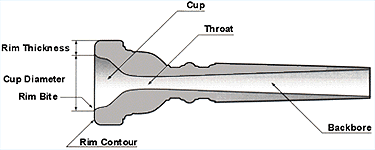
Dimensions & Shape
The dimensions and shape of a mouthpiece have a direct effect on its feel, playability, and sound. Use the parameters described below as a general guide when shopping around.
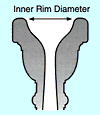 Rim Diameter (Internal)
Rim Diameter (Internal)
In general, a small rim diameter makes it easier to play high notes and can increase endurance, but volume is limited. A larger rim diameter, on the other hand, provides plenty of volume and easy low tones but endurance may be sacrificed. The ideal rim diameter will depend on each player's physical traits, playing style, and musical requirements. The factors involved are very individual... some players spend years searching for the perfect rim.
Rim Contour
Since this is the part of the mouthpiece that comes into direct contact with the player's lips, it is a critical parameter for playing comfort. Rim contour also has a large effect on attack clarity. A maJorlty of players prefer a relatively flat contour with the peak closer to the inner edge. This type of contour is generally considered to be the most stable, providing optimum contact with the rim bite (described below). Avoid mouthpieces with scratched or pitted contours.
Rim Thickness
Although a thick rim provides greater lip contact area for easy high notes and extended endurance, lip movement is limited so you lose tonal flexibility. A rim that is too thin offers plenty of control over a wide range, but can quickly cause fatigue. Beginning players are probably better off choosing a rim of medium thickness, but the best approach is to play a variety of types and choose the one that feels the most natural and plays the easiest.
Rim Bite
The bite of the rim has a large influence on attack clarity and pitch control. Mouthpieces with a sharp bite generally make it easier to produce accurate, stable pitch and a rich tone. If the bite is too sharp, however, lip control is limited and it becomes difficult to make smooth note-to-note transitions. A sharp bite can also be painful on the lips and reduce endurance. At the other extreme a round, very soft bite may be comfortable to play, but will produce a blurred attack and poorly defined pitch.
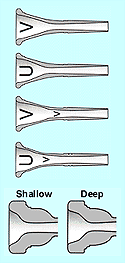 Cup Silhouette
Cup Silhouette
Cup silhouette encompasses both cup depth and shape. Shallow cups produce a brighter tone and are more controllable in the higher register at the expense of volume. Deep cups offer a dark tone, easy low notes, and plenty of power. Cup shapes range from "U" shapes to "V" shapes. The more "U" shaped a cup is, the brighter the sound and the easier it is to play in the high register. As a cup approaches the "V" shape the sound becomes darker and the lower register becomes easier to play. Some French horn mouthpieces employ a "double cup" design -- essentiaIly a combination of the "U" and "V" shapes to facilitate playing throughout the instrument's range.
Shoulder
Most "U" shape cups have a fairly sharp shoulder which results in easy-to-play resistance and a well-defined, bright sound. "V" shape cups have a smoother rounder shoulder which produce low resistance and a soft, dark tone.
Throat Diameter
The throat is the narrowest portion of the mouthpiece bore, and therefore the point of highest sound pressure. The diameter and length of this part of the mouthpiece have a major influence on playing resistance. A narrow, long throat produces high resistance which contributes to fast response, brilliant tone, and enhanced playability in the high register. A wide, short throat is more playable in the low register and is capable of producing greater volume - but requires lots of air from the player and can lead to fatigue.
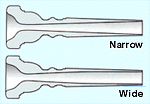 Backbore
Backbore
The "backbore" is the inner section of the mouthpiece bore which follows the throat. The backbore has a complex flare which can significantly affect high-register pitch. The diameter of the backbore also influences timbre and resistance. Like most other diameter-related parameters, a narrow backbore results in increased resistance, brighter tone, and easier playing in the high register. A larger backbore decreases resistance for darker tone and easier playing in the lower range.
Shank
This parameter is of prime importance in determining how well a mouthpiece matches your instrument. The taper of the mouthpiece shank must perfectly match the instrument's receiver there should be absolutely no "play". The outer diameter of the shank determines how deeply the mouthpiece seats in the receiver, thus affecting overall pitch, the accuracy of individual notes, and even playing feel.
Yamaha Numbering System
 |
Cup Diameter = 5 - 68 (narrow - broad) Cup volume + shape = A - E (shallow - deep); C = standard Rim Contour = 1 - 5 (flat - round); 3 = standard Backbore = a - e (narrow - broad); 3 = standard |
Material, Weight & Finish
Perhaps less obvious than the shape parameters described in the preceding section, material weight, and finish are of the utmost importance in determining a mouthpiece's sound and playability.
Material
The most common material used for mouthpiece production today is brass (specific gravity 8.5). Some older French horn mouthpieces were made from German silver (specific gravity 8.8), and these tend to have a "harder" tone than brass types.
Silver mouthpieces are a unique alternative to brass, characterized by a dark, powerful tone with superior projection. Yamaha Silver 925 Series silver mouthpieces are manufactured from solid, top-quality sterling silver (specific gravity 10.4). Their unique resistance makes them suitable for experienced players who can take full advantage of the extraordinary dark tone these fine mouthpieces are capable of delivering.
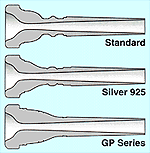 Weight
Weight
Generally speaking, light mouthpieces exhibit fast, flexible response while heavier types produce a more focused tonal core and are more suited to powerful playing styles The Yamaha Standard Series concentrates on the medium weight range for the best balance for all-round playing, while the GP Series and Silver 925 Series feature a more specialized weight balance for outstanding expressive scope and versatility.
Finish
Silver plate is an ideal finish for brass mouthpieces. As long as the thickness of the plating is sufficient, silver affords exceptional durability and will not flake or peel. Silver is also non-toxic to most players unlike the nickel under-layer used by some other manufacturers.
Gold plate offers a smooth, luxurious feel that actually contributes to enhanced lip control flexibility. In the Yamaha GP Series and some Signature Series models the gold plate extends to the inside bore of the mouthpiece, achieving a unique tone and exceptionally smooth airflow.
In some cases no plating is applied at all. Yamaha Silver 925 Series mouthpieces are simply buffed using a special technique usually reserved for top-quality French horns - to bring out the natural beauty and acoustic qualities of the base material.
Generally speaking, gold-plate finishes provide the smoothest feel with unrestricted lip movement, while unplated silver gives the best "grip". Silver plate falls somewhere between gold-plate and unplated silver.